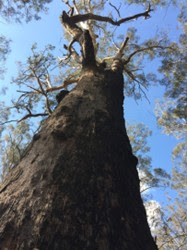Adapted from the TFNC May 2025 newsletter reports of C. Stephenson & D. Ford.
 |
Skeletal remains
of the victims
Photo: K. Crompton |
April
06 dawned cool and cloudy as we passed Toowoomba’s flourishing trees, lawns,
parks and gardens bright with Autumn red, gold and yellow to Deongwar State Forest where huge fallen eucalypts
were of great interest with their coverings of rotting leaf and bark litter,
fungi, mosses and lichens. Further along the forest track, we entered our destination, a 40 acre Land for Wildlife property,
purchased after the devastating 2019 fires. This
property of hoop pine dominated softwood scrub, bordered on three sides by
predominantly eucalypt State Forest, was enveloped and destroyed by a huge
fiery cloud. Tall, skeletal remains of the victims of the fire towered over the lush, green re-growth. Only two of the hoop pines remained, damaged, but alive. The steadfast work of the owners in
clearing lantana, and planting hoop pine and other native seedlings is showing
positive results. However, steep slopes and aggressive growth of invasive
lantana will be an ongoing challenge.
Over
300mm of welcome rain in March has aided in the rapid regeneration of
pioneering species, especially green wattle. (up to 6 metres high). The
resilience of eucalypts is evident from the obvious coppicing from the base of
burnt trees. Naturally regenerating hoop pine seedlings were seen as we
meandered along the walking tracks close to the creek.
Of
great interest was the spectacular array of abundant fungi
 |
Chocolate Tube Slime
Stemonitis splendens
Photo: B. Dyke |
- so varied in type,
size, shape and colour…red, orange, yellow, purple, green, white, cream, brown,
all working to decompose the many charred tree trunks and branches on the
forest floor or still standing. A peaceful, camouflaged bird hide made by Scott,
was a welcome resting spot to listen to the elusive birds in the surrounding
bush, before descending, past several brush turkey mounds, and a pleasing
mixture of naturally regenerating dry rainforest plants, to the gently flowing
creek.
In
the creek bed was a tiny waterfall, formed by a buttress root, all that
remained of a large fig tree, that had been incinerated in the all-consuming
fire. Many thanks to our hosts for their welcome, and willingness to share
their property. Their provision of maps, species lists and marked, maintained
tracks was most helpful and very much appreciated. We wish them success in
their endeavours to reawaken this special place.
Deongwar
species list - 06 April 2025 (Collated by C. Stephenson)
Birds: Yellow-tailed Black Cockatoo (in vicinity of Hampton Information
Centre), Rainbow Lorikeet, King Parrot, Welcome Swallow, Laughing Kookaburra,
Eastern Yellow Robin, Golden Whistler, Rufous Whistler, Grey Shrike-thrush,
Spectacled Monarch, Leaden Flycatcher, Rufous Fantail, Grey Fantail, Willie
Wagtail, Eastern Whipbird, Superb Fairy-wren, Yellow-throated Scrub-wren,
White-browed Scrub-wren, White-throated Gerygone, Brown Thornbill,
White-throated Treecreeper, Lewin’s Honeyeater, Yellow-faced Honeyeater, Brown
Honeyeater, Eastern Spinebill, Striated Pardalote, Silvereye, Red-browed Finch,
Pied Butcherbird, Australian Magpie, Pied Currawong, Torresian Crow.
Reptiles: Yellow-faced Whipsnake.
Insects: Grass Dart or skipper Ocybadistes sp., Australian Emperor,
Yellow Migrant, Wandering Percher, Evening Brown, Blue Skimmer, Brown Ringlet,
Hibiscus Harlequin Bug Tectocoris diophthalmus, Monarch Butterfly.
Toowoomba Field Naturalist members went on a NSW camp in March - Armidale & Myall Lakes National Park. The report will be posted later. Watch this space!






